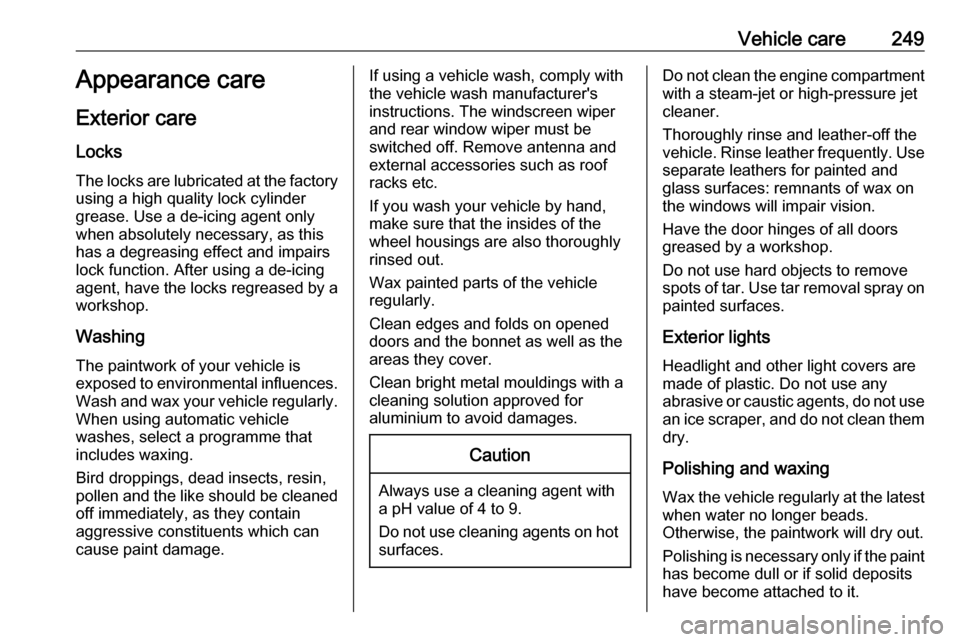roof rack OPEL COMBO E 2019.75 Manual user
[x] Cancel search | Manufacturer: OPEL, Model Year: 2019.75, Model line: COMBO E, Model: OPEL COMBO E 2019.75Pages: 285, PDF Size: 10.68 MB
Page 74 of 285

72StorageStorageStorage compartments................72
Glovebox ................................... 72
Cupholders ................................ 72
Front storage ............................. 73
Overhead console .....................74
Underseat storage .....................75
Centre console storage .............76
Footwell storage ........................76
Load compartment .......................77
Ladder flap ................................ 77
Load compartment cover ...........78
Lashing eyes ............................. 81
Cargo management system ......81
Safety net .................................. 82
Load compartment grille ............84
Warning triangle ........................87
First aid kit ................................. 87
Roof rack system .........................87
Roof rack ................................... 87
Loading information .....................88
Overload indicator .....................89Storage compartments9Warning
Do not store heavy or sharp
objects in the storage
compartments. Otherwise vehicle
occupants could be injured by
objects being thrown around in the
event of hard braking, a sudden
change in direction or an accident.
Glovebox
To open the glovebox pull the handle.
The glovebox should be closed whilst driving.
Cupholders Front cupholder
Cup holders are located at the sides
of the instrument panel.
Page 89 of 285

Storage87side pass one strap on each headrestraint.
With fitted protective cover the
maximum load on each of the folded
backrests is 100 kg.
Warning triangle
Depending on version, the warning
triangle can be stowed in the load
compartment. Secure it with the
elastic straps.
First aid kit
Depending on version, the first aid kit can be stowed in the load
compartment.
Roof rack system
Roof rack
For safety reasons and to avoid
damage to the roof, the vehicle
approved roof rack system is
recommended. For further
information contact your workshop.
Follow the installation instructions
and remove the roof rack when not in use.
Mounting roof rack
Vehicles with roof railing
Page 90 of 285

88StorageMounting points are located at the
bottom of the roof railing.
Fasten the roof rack according to the
installation instructions delivered with
the roof rack.
Vehicles without roof railing
To fasten a roof rack, unscrew the
caps in the roof strips. Insert the
mounting provisions, as instructed, in the retainer.
Loading information
● Heavy objects in the load compartment should be placed
against the seat backrests. Make
sure that the backrests are
securely engaged. If objects can
be stacked, heavier objects
should be placed at the bottom.
● Prevent sliding of loose objects by securing them with straps
attached to the lashing eyes
3 81.
● Do not allow the load to protrude above the upper edge of the
backrests.
● Do not place any objects on the rear luggage cover or the
instrument panel, and do not cover the sensor on top of theinstrument panel.
● The load must not obstruct the operation of the pedals, parking
brake and gear selector, or
hinder the freedom of movement
of the driver. Do not place any
unsecured objects in the interior.
● Do not drive with an open load compartment.9Warning
Always make sure that the load in
the vehicle is securely stowed.
Otherwise objects can be thrown
around inside the vehicle and
cause personal injury or damage
to the load or car.
● The payload is the difference between the permitted gross
vehicle weight (see identification
plate 3 259) and the EC kerb
weight.
Page 91 of 285

Storage89To calculate the payload, enter
the data for your vehicle in the
weights table at the front of this
manual.
The EC kerb weight includes
weights for the driver (68 kg),
luggage (7 kg) and all fluids (fuel
tank 90% full).
Optional equipment and
accessories increase the kerb
weight.
● Driving with a roof load increases
the sensitivity of the vehicle to
cross-winds and has a
detrimental effect on vehicle
handling due to the vehicle's
higher centre of gravity.
Distribute the load evenly and secure it properly with retaining
straps. Adjust the tyre pressure
and vehicle speed according to
the load conditions. Check and
retighten the straps frequently.
Do not drive faster
than 120 km/h.
The permissible roof load is:● 80 kg for vehicles with roof railing
● 100 kg for vehicles without roof railing and with two roofracks
● 150 kg for vehicles without roof railing and with three
roof racks, except vehicles
with seven seats
● 100 kg for vehicles without roof railing and with three
roof racks and seven seats
The roof load is the combined weight
of the roof rack and the load.
Overload indicator
The overload indicator checks
whether the vehicle is overloaded.
The function is designed to help
avoiding overload and the
consequent risks such as unstable
road behaviour, tyre blowout,
premature wear etc.
If an overcharge is imminent, ON and
% are illuminated.
If the vehicle is overloaded, ON, %
and & are illuminated. In addition,
& is illuminated in the instrument
cluster.
Page 187 of 285

Driving and operating185Complete attention is always required
while driving, and you should be
ready to take action and apply the
brakes and / or steer the vehicle to
avoid crashes.
We recommend to deactivate the
system in the vehicle personalisation
in the following cases:
● when towing a trailer or caravan
● when carrying long objects on roof bars or a roof rack
● when the vehicle is being towed with the engine running
● when a spare wheel is fitted that is smaller than the other wheels
● before using an automatic car wash with the engine running
● before placing the vehicle on a rolling road in a workshop
● if the windscreen has been damaged close to the camera
● if the front bumper has been damaged
● if the brake lamps are not workingFault
In case the system requires a service, m is illuminated in the instrument
cluster, a message is displayed in the Driver Information Centre and an
audible signal is given.
If the system does not work as it
should do, vehicle messages are
displayed in the Driver Information
Centre.
Vehicle messages 3 117.
Front pedestrian protection Front pedestrian protection may help
to avoid or reduce the harm caused
by front-end crashes with pedestrians when driving forward.
The system uses the front camera in
the windscreen to detect a pedestrian
directly ahead in your path.
Front pedestrian protection can
detect and alert to pedestrians in a
forward gear at speeds between
5 km/h and 60 km/h.
During nighttime driving, system
performance is limited.9 Danger
Front pedestrian braking does not
provide an alert or automatically
brake the vehicle, unless it detects
a pedestrian.
The system may not detect
pedestrians, including children,
when the pedestrian is not directly ahead, not fully visible, not
standing upright, or when part of a
group.
Front pedestrian protection includes:
● detecting front pedestrian ahead● front pedestrian alert
Front pedestrian protection is
activated together with forward
collision alert.
Forward collision alert 3 181.
Detecting front pedestrian ahead
A pedestrian ahead up to a distance
of approx. 40 m is indicated by a
symbol in the instrument cluster.
Page 251 of 285

Vehicle care249Appearance care
Exterior care LocksThe locks are lubricated at the factoryusing a high quality lock cylinder
grease. Use a de-icing agent only
when absolutely necessary, as this
has a degreasing effect and impairs
lock function. After using a de-icing
agent, have the locks regreased by a
workshop.
Washing
The paintwork of your vehicle is
exposed to environmental influences. Wash and wax your vehicle regularly.
When using automatic vehicle
washes, select a programme that
includes waxing.
Bird droppings, dead insects, resin,
pollen and the like should be cleaned
off immediately, as they contain
aggressive constituents which can
cause paint damage.If using a vehicle wash, comply with
the vehicle wash manufacturer's instructions. The windscreen wiperand rear window wiper must be
switched off. Remove antenna and
external accessories such as roof
racks etc.
If you wash your vehicle by hand,
make sure that the insides of the
wheel housings are also thoroughly
rinsed out.
Wax painted parts of the vehicle
regularly.
Clean edges and folds on opened
doors and the bonnet as well as the
areas they cover.
Clean bright metal mouldings with a
cleaning solution approved for
aluminium to avoid damages.Caution
Always use a cleaning agent with
a pH value of 4 to 9.
Do not use cleaning agents on hot surfaces.
Do not clean the engine compartmentwith a steam-jet or high-pressure jet
cleaner.
Thoroughly rinse and leather-off the vehicle. Rinse leather frequently. Use
separate leathers for painted and
glass surfaces: remnants of wax on
the windows will impair vision.
Have the door hinges of all doors
greased by a workshop.
Do not use hard objects to remove
spots of tar. Use tar removal spray on
painted surfaces.
Exterior lights
Headlight and other light covers are
made of plastic. Do not use any
abrasive or caustic agents, do not use an ice scraper, and do not clean them
dry.
Polishing and waxing
Wax the vehicle regularly at the latest when water no longer beads.
Otherwise, the paintwork will dry out.
Polishing is necessary only if the paint
has become dull or if solid deposits
have become attached to it.
Page 283 of 285

281Overload indicator................89, 106
Overrun cut-off ........................... 150
P Panoramic view system ..............196
Parking ................................ 21, 153
Parking assist ............................ 186
Parking brake ..................... 106, 163
Parking heater ............................ 141
Parking lights ............................. 129
Particulate filter ........................... 154
Passenger side camera ..............196
Performing work ........................215
Peripheral lighting .......................132
Power button .............................. 147
Power outlets ............................... 96
Power windows ............................ 42
Preheating ................................. 107
Puncture ..................................... 241
R Radio Frequency Identification (RFID) ..................................... 276
Radio remote control ...................23
Rain sensor ................................ 109
REACH ....................................... 272
Reading lights ............................ 130
Rear doors ................................... 32
Rear fog light .............109, 129, 225
Rear view camera ...................... 199
Rear view display .................41, 116Rear windows .............................. 44
Rear window wiper and washer ..95
Recommended fluids and lubricants ........................ 257, 261
Refuelling ................................... 207
Registered trademarks ...............272
Removing seats ............................ 54
Reversing lights .........................129
Ride control systems ..................166
Roadside assistance ..................122
Roller blinds ................................. 45
Roof .............................................. 46
Roof load ...................................... 88
Roof rack ..................................... 87
S
Safety net .................................... 82
Seat adjustment ....................... 7, 49 Seat belt ........................................ 8
Seat belt reminder .....................103
Seat belts ..................................... 57
Seat folding .................................. 50
Seat heating ................................. 52
Seat position ................................ 48
Second row seats ........................53
Selective catalytic reduction .......155
Selective ride control ..................168
Selector lever.............................. 158
Service ............................... 144, 254
Service display .......................... 102Service information ....................254
Service vehicle soon .................. 105
Side airbag system ......................63
Side blind spot alert ............110, 194
Sidelights .................................... 124
Side turn lights ........................... 228
Sliding door .................................. 31
Sliding side door ........................... 31
SOS ............................................ 122
Spare wheel ............................... 241
Speed limiter....................... 110, 173
Speedometer ............................. 100
Starting and operating ................146
Starting off ................................... 19
Starting the engine ....................148
Steering ...................................... 146
Steering wheel adjustment ......9, 92
Steering wheel controls ...............92
Stop engine ................................ 105
Stop-start system........................ 150
Storage ......................................... 72
Storage compartments .................72
Sunvisor lights ........................... 131
Sun visors .................................... 45
Symbols ......................................... 4
System check ............................. 105
T Tachometer ............................... 101
Tailgate ......................................... 33